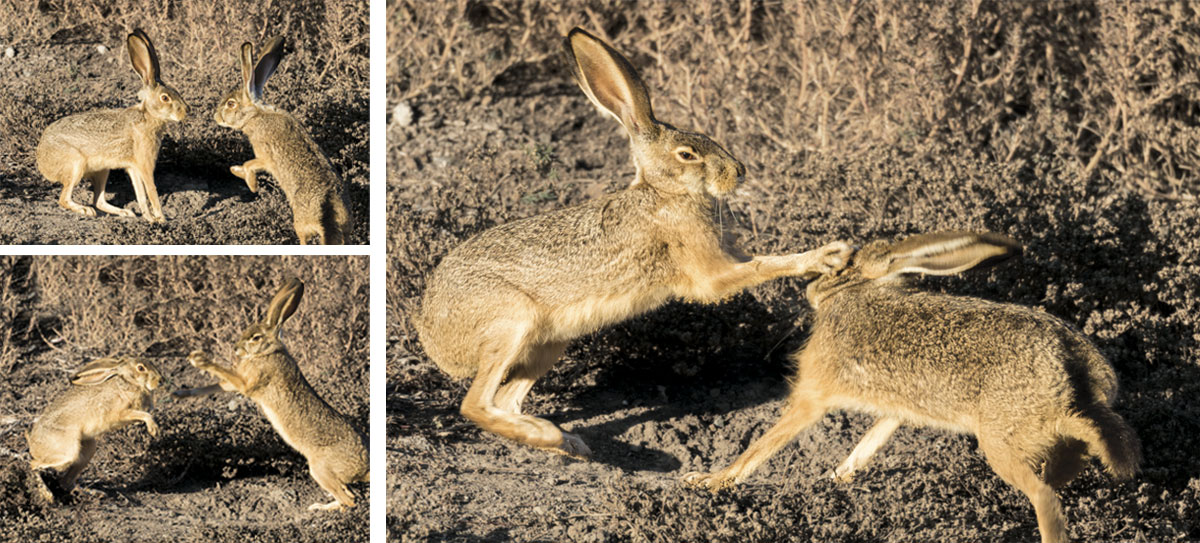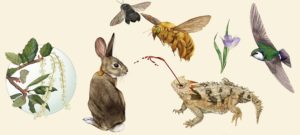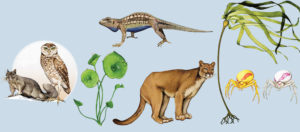“The March Hare will be much the most interesting, and perhaps as this is May it won’t be raving mad—at least not so mad as it was in March.”
–Alice in Wonderland
Hares—those long-eared, long-legged exaggerations of the rabbit—must be the laughingstock of the springtime meadow. So deft and reclusive much of the year, they seem to have lost all sense come March and April. Chasing each other across grassy terrain, a pair of hares will spin around to face off, lashing out their forelegs in frenzied blows, like boxers in a ring. Then they’re off running again. That old English idiom, circa the 16th century, “mad as a March hare,” pretty well describes their springtime escapades.
But why do they behave so seemingly foolishly? Contrary to popular belief, the jousters aren’t two males (jacks) competing with each other. Rather, it’s the ovulating jills (females) fighting off multiple suitors (up to 10 at a time!) and waiting for the most persistent and fit fellows to win them over.
Scientists suspect that the testosterone-induced chase in fact has a rational purpose: It most likely plays an important role in triggering ovulation in the female. Hares (and many other species) only ovulate after copulation or some other stimulation, in this case wild leaping and running. While studies of the European brown hare have found that these skirmishes are more often seen in the springtime, owing to the shorter grass and lengthening days, they can happen at any time during the hare’s long breeding season. In the Bay Area, that spans from the end of January through August.
The only hare found in the Bay Area is the black-tailed jackrabbit. Despite the name, it is not a rabbit but a close relative in the order Lagomorpha (which also includes the mountain-dwelling pika). Lepus californicus is common to many open patches in Bay Area wildlands, but the black-tailed is acclimated in particular to arid areas, such as sagebrush habitats and desert scrubland; its long ears act as thermoregulators. It’s been found that the warmer the climate, the longer their ears.
Those long cupped ears pivot as the hare tracks sound with its finely tuned hearing, its best protection against umpteen predators, ranging from owls and hawks to coyotes and bobcats. Black-taileds are such an essential source of sustenance within their ecosystems, one study found that when their population plummeted, coyote predation on lambs spiked. No wonder hares give birth to 14 leverets on average annually.
Meals for many, hares are also notorious eaters in agricultural fields. When hare numbers shot up, as they used to, in five- to 10-year boom-and-bust cycles during the early days of western agriculture, farmers would gather for so-called “bunny bashes” to round up jackrabbits and club them to death. A sad story, but someone did this measurement: 149 black-taileds can eat as much forage as one cow.
According to Janet Rachlow, a University of Idaho ecologist, such major population swings haven’t occurred since the early 1980s, probably due to large-scale landscape changes. But hares’ numbers are still healthy, and Rachlow does see them when she’s out researching their petite cousin, the pygmy rabbit. “They jump out of the sagebrush and scare the hell out of me. They’re terrifying,” Rachlow says, though not to demean them.
Here’s one key difference between hares and rabbits. Though all lagomorphs are the very essence of a prey species, rabbits dive into burrows when threatened, while hares hunker down in place until a predator gets close and only then spring to action. They use their long limbs and agile bodies to flee at a speed of 45 miles per hour for a mile or more. They swerve and zigzag and flash their ears and tails to confound a pursuer. They go from “mad” to decidedly wily.
There’s a long riff on the theme of the trickster hare. Bugs Bunny was clearly a hare, according to an expert resource on lagomorphs, Rabbits: The Animal Answer Guide; in fact, Bugs first appeared in a 1940 film called A Wild Hare. So was the Trix cereal rabbit, judging by its appearance, as well as the fabled and clever Br’er Rabbit, a hare that originated in West African stories.
Their trickster reputation “makes sense because they are nature’s most perfect food—and yet they get away,” says Mary Pounder, who leads the lagomorph foster care team for WildCare, a San Rafael–based animal rescue group. “Their ability to evade predators is pretty amazing, and they have so many things at their disposal to help.”
Thanks to all those adaptations black-tailed jackrabbits can get away with their wild spring antics, and we can have the pleasure of watching them.





